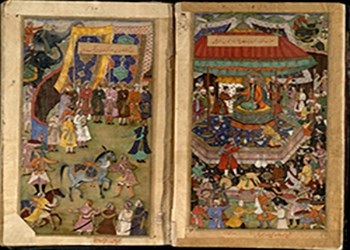
Royal Library
The Golestan Palace World Heritage Royal Library and Manuscript Treasure was established in the early 18th century with the efforts of Fath Ali Shah Qajar and was called the Royal Library.
Fath Ali Shah paid special attention to the noble art of calligraphy and the fine art of painting, and the master artists of his time such as: Zein al-Abidin Ashraf, Mohammad Shafi Ebin Mohammad Ali Tabrizi, Vesal Shirazi and hundreds of famous artists in that era showed great exquisiteness in the field of art and presented their precious and unique works to the kings. These artworks found their way to the library, and in the same era, skilled painters and art maters created the works in their special Qajar style.
Names such as: Agha Reza, Agha Sadiq, Khandan Wesal, Ali Ashraf, Sani al-Mulk, Mahmoud Khan Malik Al-Shoara, Kamal al-Mulk, Ismail Jalaer and other painters and gilders promoted the art by creating their charming and exquisite works and the Royal Library by collecting the books of the libraries of the past sultans, such as Safavid and Zandiyeh dynasties, were finally established in Golestan Palace.
During the time of Haj Mirza Aghasi, when the Royal Library was under direct supervision, religious books were collected in abundance, some of which were given in the form of rewards, and after the death of Mohammad Shah Qajar during the reign of Naser al-Din Shah, i.e. in the middle of the 18th century, this library was renamed to the Royal Library or the Government Museum Library and began to extend further. Numerous notes in Naser al-Din's handwriting can be seen in most of the copies of the Royal Library.
At the end of the Qajar reign, no attention was paid to the Royal Library, and in general, it can be said that the creation of works of art began to decline, and many books were dispersed and sent to foreign countries, and were taken by uncommitted profiteers, such as Lesan al-Dowleh. He was one of the librarians of that time who stolen some of the works and kept them under the soil of the garden, under the attic and inside a water pond and as a results many of the manuscripts were seriously damaged.
Until the end of the Qajar period, some other exquisite works were donated from the library, one of them is one of the masterpieces of calligraphy and painting. This was an album containing 60 pieces of "Hamze Nameh" paintings, which is considered one of the greatest painting works of the Iranian and Indian schools.
During the Pahlavi era, with the establishment of the National Library, about 14 thousand volumes of books were transferred from the Royal Library to the National Library, and the rest of the manuscripts were kept in the safe, and finally, the current treasure of the library in the historical complex of Golestan Palace began its activity, and it is hoped that we will be able to increase the productivity of the library with effective measures and good plans and achieving good results in providing reference services for researchers and conducting research and printing manuscripts.
At present, there are more than 3200 manuscripts in the precious treasury of Golestan Palace, and among them we can name Golshan Moraqqa, Biasongori Shahnameh, Hezar – o - Yekshab.
Providing services:
- The original works are not displayed at all.
- Providing a CD, print, microfilm or photo of all parts of the manuscript is subject to completing the request form and mentioning the type of research and paying the fee.
- The original work is not available to the researcher and in special cases where the researcher needs to see parts of the original work, after the approval of the library director and the manager of the executive department, the original copy for a limited period of time exclusively in the repository hall and under the full supervision of the librarian, is available to the researcher.
- It will be possible to use scans or digital photos of lithographs for researchers by presenting a valid introduction letter and the permission of the head of the department.
Documents required by researchers and working days:
Respected clients must submit a valid letter of introduction from their workplace or education or related bodies, including their application letter and bring a valid ID card, a photo of themselves and a copy of their national card. By referring to the secretariat of Golestan Palace and going through the legal procedure and approval of deputy or management of the Golestan Palace complex and visiting the manuscript treasure office, an appointment will be set for them so that the requested work can be reviewed and declared ready to be studied.
Working days:
- From Saturday to Wednesday, from 9:00 am to 2:30 pm
- For submitting documents and registering your request please go to the secretariat of Golestan Palace
- Applicants must have a master's degree or higher.
- The official in charge: Nasrin Marjani
- Telephone: 33113335 - 8 extension 207